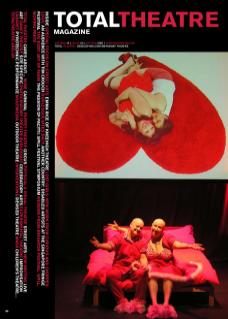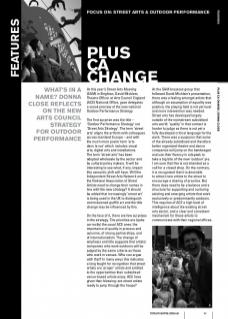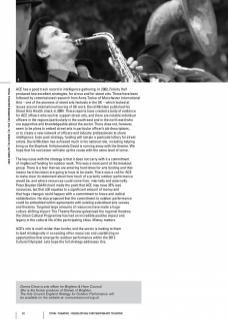At this year’s Street Arts Meeting (SAM) in Brighton, David Micklem, Theatre Officer at Arts Council England (ACE) National Office, gave delegates a sneak preview of the new national Outdoor Performance Strategy.
The first surprise was the title – ‘Outdoor Performance Strategy’ not ‘Street Arts Strategy’. The term ‘street arts’ aligns the artform with colleagues across mainland Europe – and with the much more poetic term ‘arts dans la rue’ which includes visual arts, digital arts and installations. The term ‘street arts’ has been adopted wholesale by the sector and by cultural policy makers. It will be interesting to see what, if any, impact this semantic shift will have. Will the Independent Street Arts Network and the National Association of Street Artists need to change their names in line with the new strategy? It should be added that increasingly ‘street art’ is being used in the UK to distinguish commissioned graffiti art and the title change may be influenced by this.
On the face of it, there are few surprises in the strategy. The priorities are (quite correctly) the usual ACE ones: the importance of quality in process and outcome, of strong partnerships, and of internationalism. The change of emphasis and title suggests that artists/ companies who work outdoors will be judged by the same criteria as those who work in venues. Who can argue with that? In many ways this indicates a long fought for recognition that street artists are ‘proper’ artists and entitled to the opportunities their subsidised venue-based artists enjoy. ACE have given their blessing: are street artists ready to jump through the hoops?
At the SAM breakout group that followed David Micklem’s presentation, there was a feeling amongst artists that although an assumption of equality was positive, the playing field is not yet level and more intervention was needed. Street arts has developed largely outside of the mainstream subsidised arts world: ‘quality’ in that context is harder to judge as there is not yet a fully developed critical language for the work. There was a suspicion that some of the already subsidised and therefore better organised theatre and dance companies will jump on the bandwagon and use their fluency in artspeak to take a big bite of the new ‘outdoor’ pie. I am sure that this is not intended as a call for a closed shop. On the contrary, it is recognised that it is desirable to attract new artists to the street to encourage a sharing of practice. But there does need to be a balance and a structure for supporting and nurturing existing and emerging artists that work exclusively or predominantly outdoors. This requires of ACE a high level of intelligence about the existing street arts sector, and a clear and consistent mechanism for these artists to communicate with their regional offices.
ACE has a good track record in intelligence gathering. In 2002, Felicity Hall produced two excellent strategies, for circus and for street arts. These have been followed by commissioned research from Anne Tucker of Manchester International Arts – one of the pioneers of street arts festivals in the UK – which looked at issues around international touring of UK work. David Micklem published his Street Arts Health check in 2004. These reports have created a body of evidence for ACE officers who wish to support street arts, and there are notable individual officers in the regions (particularly in the south east and in the north east) who are supportive and knowledgeable about the sector. There does not, however, seem to be plans to embed street arts in particular officer’s job descriptions, or to create a new network of officers and industry professionals to share intelligence. Even post-strategy, funding will remain a postcode lottery for street artists. David Micklem has achieved much in his national role, including helping bring us the Elephant. Unfortunately David is running away with the theatre. We hope that his successor will take up the cause with the same level of verve.
The key issue with the strategy is that it does not carry with it a commitment of ring-fenced funding for outdoor work. This was a moot point at the breakout group. There is a fear that we are entering hard times for arts funding and that means hard decisions are going to have to be made. There was a call for ACE to make clear its statement about how much of a priority outdoor performance would be, and where resources could come from, internally and externally. Peter Boyden (SAM chair) made the point that ACE may have 35% less resources, but that still equates to a significant amount of money and that huge changes could happen with a commitment to brave and radical redistribution. He also proposed that the commitment to outdoor performance could be embedded within agreements with existing subsidised arts venues and theatres. Targeted large amounts of resources have made a huge culture-shifting impact: The Theatre Review galvanised the regional theatres, the Urban Cultural Programme has had an incredible positive impact and legacy in the cultural life of the participating cities. Money matters.
ACE’s role is much wider than funder, and the sector is looking to them to lead strategically in accessing other resources and capitalising on opportunities that emerge for outdoor performance within the 2012 Cultural Olympiad. Lets hope the full strategy addresses this.
Donna Close is arts offcer for Brighton & Hove Council. She is the former producer of Streets of Brighton. The Arts Council England Strategy for Outdoor Performance will be available on the website at: www.artscouncil.org.uk


